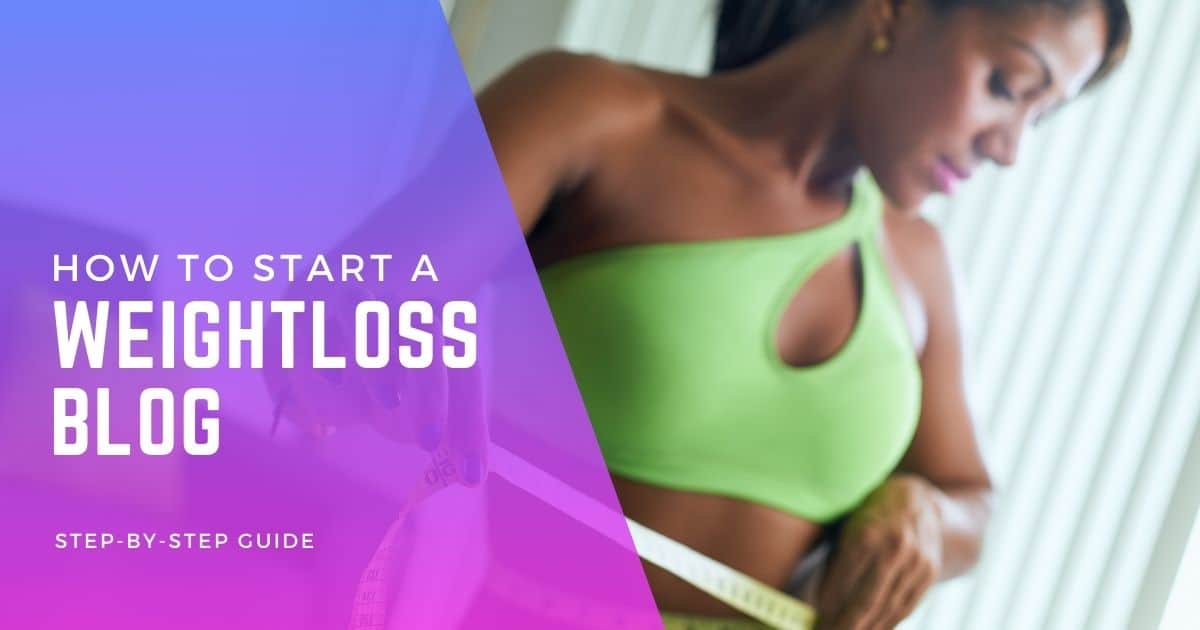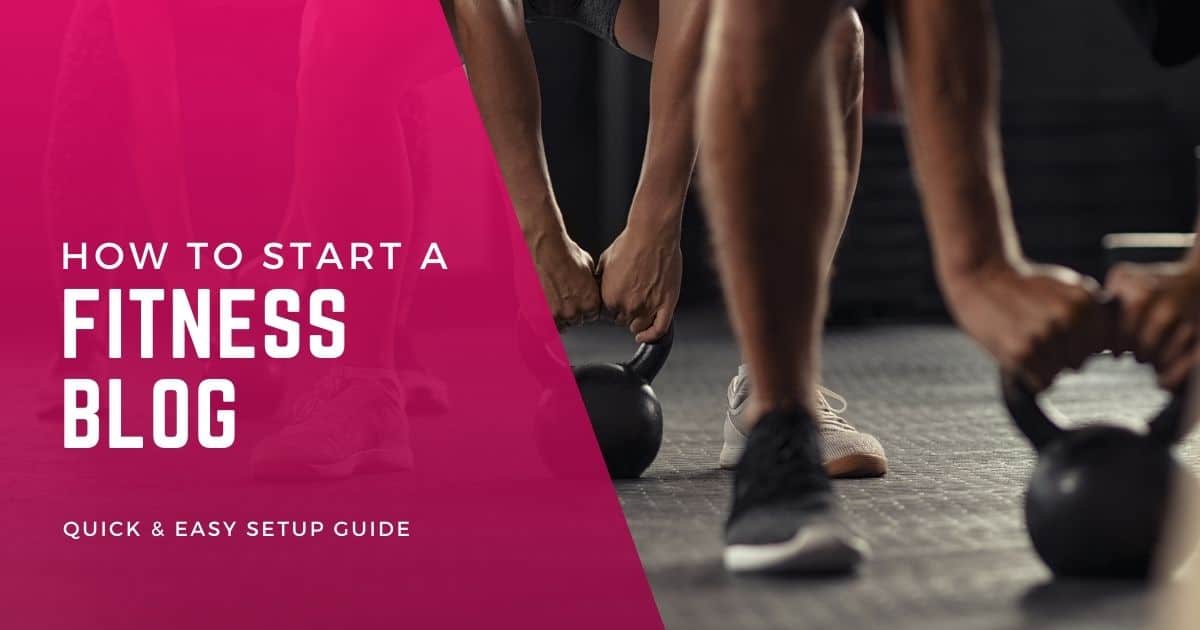Starting a blog can seem like a big task, but it doesn’t have to be. If you’ve ever asked yourself, “How do I start a weight loss blog?” you’re in the right place. We’ll break down the steps, making it simple and straightforward.
We’ve gathered expert advice and reliable sources to give you the best information. This ensures our guide is up-to-date and trustworthy.
You’ll gain the knowledge and skills to create your own weight loss blog by the end. You’ll learn how to choose the right platform, find your niche, and craft content that your readers will love. So, let’s dive in and get started!
Choose Your Niche

When starting a weight loss blog, the first step is to choose your niche. This should be something you are passionate about, as this will fuel your content ideas and keep you motivated.
Consider your target audience and the specific topics that would resonate with them. For example, if you focus on weight loss for middle-aged women, you can narrow your overall blog topic to something more specific than general wellness.
Select a domain name that reflects your blog’s content and is easy to remember. Avoid long domains, as these can be difficult to remember and may prevent your blog from standing out.
Finally, consider using a “.com” extension when naming your blog. This extension is the most trusted and familiar, which can help establish credibility with your audience.
“Understanding your target audience and choosing the right niche are key to creating a successful weight loss blog.”
What is a Weight Loss Blog?
A weight loss blog is a type of blog that focuses on sharing information, tips, and personal experiences related to losing weight. It can serve as a platform to share one’s weight loss journey, provide accountability, and offer science-based health resources and weight loss information.
Weight loss blogs can cover a variety of topics, including:
- Weight loss diets
- Weight Watchers
- Healthy living
- Healthy eating habits
Additionally, a weight loss blog can serve as a source of income through affiliate marketing, digital products, and SEO strategies.
“Starting a weight loss blog is a great way to share your journey and connect with others.”
Identifying Your Target Audience
The target audience for a weight loss blog is people of all ages who are interested in losing weight or maintaining a healthy lifestyle, with the majority of people interested in weight loss being between 25 and 34 years old.
When choosing a target audience within the weight loss blogging niche, it’s important to understand the needs and interests of your audience. Then, choose the niche topics that best address those needs. Options for a weight loss blog could include:
- Providing meal plans
- Offering fitness advice
- Discussing nutrition topics
- Providing recipes
Other niche options include promotional sites, personal contact information, deceptive sales messages, content creation, actual photos, income reports, training programs, and training equipment.
When naming your new blog, aim for a broad name that’s short and sweet. You can also use alliteration and get creative with wordplay. There are online tools that can help generate blog name ideas.
“By understanding the needs and interests of your target audience, you can create content and solutions that will be helpful and relevant to them, establishing trustworthiness on your blog.”
Setting Up Your Website

To kickstart your weight loss blog, setting up your website is the first crucial step. This process includes registering a domain name, purchasing web hosting, and creating a design and content for the website.
“Your domain name should be memorable, easy to type, and reflect your blog’s purpose.”
After selecting a suitable domain name, the next step is to purchase web hosting. We recommend Bluehost for your blog or website due to its round-the-clock customer support, money-back guarantee, and capacity to host over 2 million websites worldwide. With their 70% discount, you can secure a web hosting package for as low as $35.40 for 12 months.
Once the web hosting is in place, you can install WordPress, a popular blogging platform. This is the next step in setting up your weight loss blog. While you can choose a free or premium theme, we recommend investing in a premium WordPress theme for a more professional look and feel.
You can set up your website quickly and easily, paving the way for your own weight loss blog.
Choosing a Domain Name
The domain name for your weight loss blog plays a significant role in setting up your website. It should be:
- Easy to remember and type
- Reflective on your blog’s purpose
- Free from long or complex words
If your desired domain name is already taken, consider using synonyms or adding extra words to create a unique name. You can also use concepts related to weight loss to create an appropriate name for your blog.
“A well-chosen domain name can set the stage for a successful weight loss blog.”
If you need assistance choosing a domain name, free online domain name generators like Lean Domain Search can greatly help. They can help you find the perfect name quickly and easily.
Purchasing Web Hosting
After finalizing a domain name, the next step is to purchase web hosting from Bluehost. Bluehost offers three hosting plans – Start Up ($2.95/month through link vs. $8.99/month), Grow Big, and Go Geek – including a free domain for a year, free SSL, and 50GB of disk space. The Basic hosting plan is the most cost-effective, but you can upgrade when necessary.
Before purchasing your web hosting package, ensure your personal contact information is correct and create a strong password for your Bluehost account. Once you have purchased your web hosting package, you can access the cPanel and install WordPress.
“Bluehost is recommended for its 24/7 customer support, money-back guarantee, and its capacity to host over 2 million websites worldwide.”
Installing WordPress
The next step in setting up your weight loss blog is installing WordPress. WordPress is a powerful blogging platform that is flexible and easy to use, even for complete beginners. It offers features such as search engine optimization, social media integration, and powerful themes that help you create a website quickly and easily.
Access the cPanel and click the “Install WordPress” button to install WordPress. After the installation is complete, you can start designing your website. You can choose from thousands of free and premium WordPress themes to customize your site or create your own unique design using custom code.
“With WordPress installed, you’re ready to start designing your website.”
Designing Your Website

Designing your website is an important step in creating a successful blog, as it helps form the first impression of a brand and creates a consistent brand identity. It helps to attract visitors and provide them with an engaging user experience. The design should be visually appealing, easy to navigate, and optimized for search engine optimization (SEO). When designing your website, it is important to ensure it is compatible with the latest versions of WordPress, as many WordPress users are still using older versions.
Your website should also be optimized for mobile devices since more people use their phones to access the web. You can use various tools and services to help you design your website, including a logo maker, WordPress themes, and website builders. When selecting a theme, it is important to choose one that fits your needs and the purpose of your blog. Premium WordPress themes are often more functional, have better features, and are more cost-effective in the long run than free versions.
Creating a visually appealing and user-friendly website ensures that your blog stands out from the competition.
Selecting a Theme
Choosing the right theme for your weight loss blog is essential for creating a successful blog. The theme should reflect the purpose of your blog and the target audience you are trying to reach.
For example, if you are creating a blog about nutrition, you may want to choose a theme that includes nutrition facts, organic food shops, and other features related to health and wellness. If you are more interested in training programs and weight loss, you may want to look for a theme that includes a BMI calculator, fitness appointments, and class timetables.
When selecting a theme, make sure that it is compatible with the latest versions of WordPress and that it is easy to customize without coding knowledge or experience. You can also find themes offering alternative components and services you may need for your blog, such as a calorie calculator, training programs, and fitness equipment shop. Premium WordPress themes are often more functional, have better features, and are more cost-effective in the long run than free versions.
Selecting a theme that fits your needs ensures your blog looks professional and easy to navigate.
Creating Essential Pages
Setting up key pages is a crucial part of establishing your website. These pages, including the About, Contact, Product/Services, Blog, Privacy Policy, and Terms of Service pages, offer visitors essential information about your blog.
- The About page introduces your blog and the team behind it.
- The Contact page provides various contact methods, such as email, phone, instant messaging, social media profiles, and a physical address. It should also feature a contact form for visitor inquiries.
- The Product/Services page outlines what you offer.
- The Blog page showcases your blog posts.
- The Privacy Policy and Terms of Service pages explain how visitor data is used and the process for inquiries.
These key pages equip your visitors with the necessary information to make informed decisions.
Writing Content

Writing content is an integral part of running a successful weight loss blog. Creating quality content for your blog is essential for making money, reaching your target audience, and providing value to readers.
To start writing content, you must decide on a niche and identify your target audience. Once you have done this, you can begin to create content that speaks to this audience. Install WordPress and choose a theme that reflects the style of your blog. Then, you will be ready to start blogging and writing content, such as blog posts, product reviews, and articles.
When creating content, it is important to ensure that all of your posts are well-researched and up-to-date. Additionally, ensure the content reflects your blog’s mission and values. To ensure the highest quality content, proofread your posts for accuracy and clarity. Finally, make sure to include visuals, such as photos, videos, and infographics, to enhance the content.
With these steps, you will be well on your way to creating quality content for your weight loss blog.
Finding Inspiration
Finding inspiration for a weight loss blog can be daunting, but it doesn’t have to be. When seeking inspiration, start by researching popular weight loss blogs to understand what topics and styles are successful in the niche.
Next, consider the topics most relevant to your target audience and create content that speaks to their interests and needs. If you need more specific ideas, try using keyword research tools like Semrush to find topics related to weight loss that can be used to create content.
Additionally, you can look for inspiration outside of the weight loss niche. Consider exploring other topics that relate to health, such as nutrition, exercise, healthy recipes, healthy habits and lifestyle changes. You can also draw inspiration from personal experiences and use your story to connect with your target audience.
Crafting Quality Content
Quality content is essential for any successful blog, especially a weight loss blog. Quality content should be relevant, engaging, and useful to the reader. It should also be unique, specific, and reader-focused.
It is important to remember that creating the best content does not mean only sharing positive reviews or purely promotional sites. It’s important to share only real reviews and not deceptive sales messages.
Additionally, avoid posting only stock images or generic photos. Instead, use photos of products, training programs, and any other training equipment you discuss.
When it comes to the technical aspect of creating content, make sure to check for typos and grammar mistakes. It’s also important to use SEO strategies, such as keywords, headings, and meta descriptions, to ensure your content is optimized for search engines.
Monetizing Your Blog

Monetizing your blog is important in creating a successful weight loss blog. It is a way to generate income and sustain your blog’s growth.
There are several ways to monetize a blog, such as affiliate marketing, offering services, selling own products, using display ads networks, and creating digital products. While each method has its advantages, affiliate marketing is the most common and successful way to monetize a blog.
Affiliate marketing is an effective monetization strategy that involves promoting products and services from other companies and earning a commission whenever a purchase occurs.
It allows bloggers to create an additional income stream without investing in creating their own products or services. Furthermore, it requires minimal effort and can be done with the blog’s content.
In addition to affiliate marketing, you can monetize your blog by selling digital products. Digital products are intangible goods that can be downloaded or accessed online. Examples of digital products include e-books, software, music, and courses.
By selling digital products, you can create an additional income stream for your blog. Furthermore, digital products require minimal effort to create and can often be sold at a higher margin than physical products.
By implementing these monetization methods, you can start making more money from your weight loss blog. Monetizing your blog can also help you take your blog to the next level and create a sustainable business. With the right strategies and dedication, you can create a profitable blog that helps you reach your weight loss goals.
Affiliate Marketing
Affiliate marketing is performance-based marketing where a business rewards its affiliates for each customer brought by the affiliate’s marketing efforts. It is a great way to monetize a weight loss blog as it requires minimal effort and can be done with its content. Affiliate marketing is an effective way to monetize your audience. You promote products and services of different companies, and if someone buys them, you receive a commission for each sale.
However, there are certain things you should keep in mind while promoting products and services as an affiliate. Firstly, you should avoid making any sort of promise of results. It is also important to unlink your brand from other fitness tracker brands when creating a weight loss blog to avoid conflict of interest in promotions. Furthermore, you should research the best affiliate programs and write unique and unbiased product reviews.
You should also make sure to include actual photos and success stories to make your reviews more credible. Additionally, you should include income reports and training programs to engage your audience further and encourage them to purchase. Finally, you should use search engine optimization (SEO) and other techniques to increase traffic to your website.
You can maximize your affiliate marketing efforts and monetize your blog by researching the best affiliate programs, writing unique and unbiased product reviews, and avoiding conflict of interest in promotions.
Selling Digital Products
In addition to affiliate marketing, you can monetize your blog by selling digital products. Digital products are intangible goods that can be downloaded or accessed online. Examples of digital products include e-books, software, music, and courses. Depending on your niche, you can offer your audience video tutorials, cheat sheets, and other content.
By selling digital products, you can create an additional income stream for your blog. Furthermore, digital products require minimal effort to create and can often be sold at a higher margin than physical products. Additionally, you can create packages with different service levels and offer free consultations to engage your audience further.
By selling digital products, you can create an additional income stream for your blog. Furthermore, it is an effective way to engage your audience and build trust with them. With the right strategies and dedication, you can create a profitable blog that helps you reach your weight loss goals.
Promoting Your Blog

Promoting your blog is essential for increasing its visibility and reach. If you want to succeed with a weight loss blog, you need to put in the effort and have a plan of action to promote it.
A key strategy for blog promotion is Search Engine Optimization (SEO). SEO is a method of optimizing your website and content to rank higher in search engines such as Google and Bing. This will help your target audience find your blog when they search for weight loss or fitness topics.
Another important part of blog promotion is social media marketing. Social media platforms like Facebook, Instagram, and Twitter can help you reach a massive community and drive more traffic to your blog. You can post content, engage with followers, and even advertise your blog to reach a larger audience.
You can reach a wider audience and grow your blog by implementing SEO strategies and leveraging social media marketing.
SEO Strategies
SEO strategies are action plans designed to improve a website’s rankings and increase organic search traffic. When starting a weight loss blog, it is important to develop an SEO strategy to ensure the right people find your blog. To start, you must list keywords related to weight loss and your target audience. Once you have identified these, you can use them in your blog posts, titles, and meta descriptions.
Additionally, you can analyze the websites that are ranking on the first page of search engines to get an idea of what type of content is needed to compete with them. Creating high-quality content that is optimized for SEO is essential for success. You can also use tools like Semrush for competitor analysis, keyword research, and site audits.
Combining SEO and social media marketing can create a powerful promotional strategy for your weight loss blog.
Social Media Marketing
Social media marketing uses social media platforms to interact with customers to build brands, increase sales, and drive website traffic. It is a key digital marketing strategy that delivers unique benefits for brands.
Creating a profile on a social media platform is the first step to getting started. You can then use this platform to respond to search queries used by the target audience online and to share content related to weight loss. Additionally, you can join Weight Loss Clubs on Facebook and other social media platforms to interact with like-minded people and network with other weight loss blogs.
Guest posting on other blogs is another way to network and promote your own blog. By leveraging the power of social media, you can reach a larger audience and drive more traffic to your blog.
Summary
Starting a weight loss blog requires careful consideration and preparation. Identifying the right niche, understanding the needs and interests of the target audience, setting up a professional website, and creating essential pages are some of the key initial steps to take before launching your new weight loss blog. Additionally, finding inspiration for content, writing with an eye-catching approach, and optimizing for search engines are important for creating quality content that will keep readers engaged and coming back for more.
Finally, monetizing the blog through affiliate marketing, selling digital products, and utilizing SEO strategies and social media marketing will help ensure success and sustainability. This article provides a comprehensive guide and step-by-step instructions on how to start a weight loss blog. With the right planning and dedication, any aspiring blogger can become successful in this field by following these straightforward steps.
Frequently Asked Questions
How do I write a blog to lose weight?
To write a blog for weight loss, start by deciding on the focus of your blog and choosing a weight loss niche. Next, choose a blogging platform, purchase a domain name, and install a theme for your blog. Finally, create essential pages, craft a logo, and begin blogging with a professional tone while making a connection with the reader.
How do I start a weight loss journal?
To start a weight loss journal, decide on a medium – paper or digital. Record daily entries of your meals, physical activities, weight, and emotions. Include specific goals and progress milestones. Regularly reviewing this journal will help you identify patterns, celebrate successes, and stay accountable on your weight loss journey.
Is the weight loss niche profitable?
Yes, the weight loss niche can be profitable. Its constant global demand offers high earning potential through various sources such as fitness programs, diet supplements, meal plans, and personalized coaching. Success hinges on effective, ethical marketing and providing unique products or services.
How do I create a diet blog?
Create a diet blog by first selecting your niche. Choose a blogging platform, then register a domain name and arrange web hosting. Customize your blog’s appearance, compose relevant, diet-focused content, and implement SEO to optimize visibility. Utilize social media for promotion and consider multiple monetization methods.



